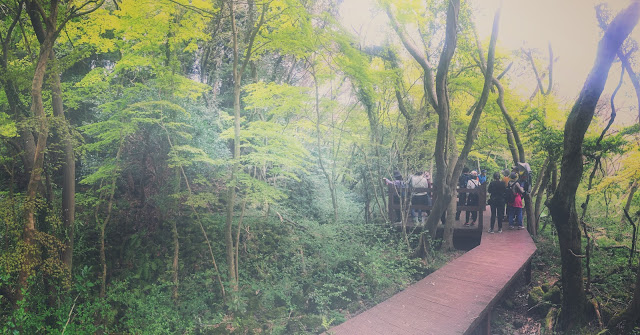I checked off Seongsan Ilchulbong and Halla Mountain from my "UNESCO World Heritage Sites to Visit" list when I visited Jeju for the first time in the spring of 2018. Geomun Oreum and Manjanggul Cave would have to be accomplished on the next visit. Luckily, that opportunity came the following year.
There are three trails around Geomun Oreum to choose from:
- Summit Course — 1.8 km / 1 hour
- Crater Course — 5.5 km / 2.5 hours
- Full Course — 10 km / 3.5 hours
I signed my friend and I up for the crater course. No wonder we were the only foreign guests—the guided tour was in Korean! We made many stops, some historical (such as WWII Japanese military tunnels, and old charcoal kiln sites used from the 1900s to the 1970s), some natural (like a lava collapse trench, and a vertical lava tube). I had no clue what the guide was on about at most of them, but I am sure it was something significant. A few areas we stopped at, thankfully, had signboards with an English translation.
It was a very easy 2.5-kilometer hike: there were no steep climbs and the hiking trail was mostly on a boardwalk. I would probably have appreciated the hike more if they had an English-speaking guide or at least, an English audio guide, or even a brochure.









The meeting point for the Geomun Oreum hike is at the Geomun Oreum Information Desk, which is just across the Jeju World Natural Heritage Center. For those who don't want to hike around Geomun Oreum, the Jeju World Natural Heritage Center offers an indoor museum, with an exhibit hall and a 4D theater, where one can learn about Jeju Island and its Natural Heritage sites.
While waiting for our Geomun Oreum hike, my friend and I explored Jeju World Natural Heritage Center. The museum staff enthusiastically took us (almost dragged us in his enthusiasm!) to the 4D theater since we were just in time for a show, and though the 20-minute story was entirely in Korean, we did enjoy it!
The Heritage Center is a good place to visit if you want to get a glimpse of Jeju's natural heritage sites but have no time to see (or hike, like Mount Halla or Seongsan Ilchulbong) the real thing.




Directions by bus: From Jeju Intercity Bus Terminal, take bus 201 to 김녕리 Gimnyeong-ri bus stop (55 minutes) then transfer to bus 711-1 or 711-2 to 만장굴입구 Manjanggul bus stop (10 minutes).
Geomun Oreum has a lava tube system stretching 36 kilometers and includes one of the largest lava tubes in the world: Manjanggul Lava Tube. Manjanggul Lava Tube is about 7.4 kilometers long but only 1 kilometer is open to the public.
Manjanggul Lava Tube has three entrances; the second entrance is the only one that's open to the public. The walk through the lava tube is damp, with puddles here and there (be sure to wear waterproof shoes!). The area is lit and one can see interesting formations caused by lava flow from thousands of years ago, such as lava flowlines, lava stalactites, lava stalagmites, etc. The farther you venture into the tube, the colder it gets. And the reward as you reach the end of the 1-kilometer walk is a large lava column!



Jeju and Busan, April 2019
Jeju Accommodation: Jeju R Hotel & Guesthouse
Traveling Around Jeju by Bus Plus KakaoMap (2019)
Eats from Jeju City Restaurants I Can't Read the Names Of
Jeju City Lights: Iho Tewoo Beach and Jeju Light Art Festa
Jeju's UNESCO World Heritage Sites: Walking Above- and Below-Ground (you're here!)
Art and Nature in Seogwipo City
Jeju Olle: Udo Island
Jeju Olle: Gapado Island
Busan Accommodation: One Way Guesthouse
Where and What We Ate in Busan


No comments:
Post a Comment